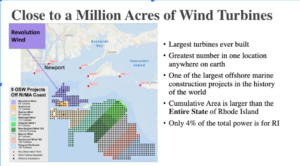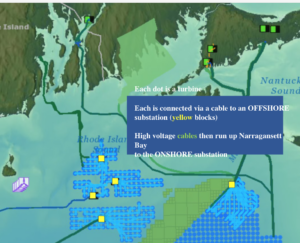Supposed Guardians of Rhode Island’s Waters Sell Out To Big Wind

Once considered Rhode Island’s most esteemed environmental Non-Profit, Save the Bay Rhode Island is now failing to operate in accordance with its mission. With the nation’s first offshore turbine farms, one of the largest marine construction projects in history, going live in waters just 12- 24 miles off the Rhode Island coasts – locals, preservationists, fisherman, and boating enthusiasts are asking, “Where is Save The Bay?”
Since the 1970’s, when citizens came together to fight an oil refinery proposed in Tiverton, Save The Bay has been considered the leader of environmental stewardship in Rhode Island. For over forty years, Save the Bay has “worked to protect, restore, and improve the ecological health of the Narragansett Bay.”
They honor that legacy by claiming to serve, “as the eyes, ears and voice for Narragansett Bay.” Overseen by a board of directors and a board of trustees, as an organization, Save the Bays daily operations are run by Executive Director Topher Hamblett. The board of trustees, appointed Hamblett to his position last January.
A quick review of their website revealed that this project, one that will have implications for the State of Rhode Island, Narragansett Bay, its watershed and adjacent coastal waters for generations to come – is not mentioned. It is not mentioned in their advocacy work or in their legislative agendas. In a web tab titled BAY ISSUES , the organization reminds us that, “Narragansett Bay is truly an environmental treasure that connects communities in Rhode Island and Southeastern Massachusetts with the Atlantic Ocean.
It is our greatest public asset and the symbol of the region’s history and culture.” Why then, is the largest ocean industrialization project in this nation’s history, a project using Narragansett Bay as its electromagnetic cable route, as a wind vessel refuge, and as a cargo lane from shore to farm, not even listed as a bay issue?
To recap, in an auction bidding process, close to one Million acres of Rhode Island and Massachusetts ocean was leased to 9 separate wind companies. These companies have been selected to develop wind farms off the coast of Rhode Island. Upon completion, along with hundreds of miles of cables running up Narragansett bay, 1,000 turbines standing btw 800-1300 feet tall, covering over a million acres of ocean, along with five Substations (with living quarters and helicopter pads for maintenance) will be erected within this lease area.
According to an April 26, 2024 TAX FILING , the organization’s mission and most significant activities include, “the protection, restoration, and improvement of the ecological health of the Narragansett Bay region, including its watershed and adjacent coastal waters…” With the sonar, ship traffic and construction of these projects levying severe adverse impacts to our fisheries, marine life, habitats and ecosystems, where is the concern from Save The Bay?

The blade incident, coupled with sharks, whales and dolphins washing up on both Rhode Island and Massachusetts shores, has many asking – where is the concern of our “ocean watchdog group”?
The organization’s ‘strategy of silence’ when it comes to offshore wind is even more surprising when comparing the issues they do speak vocally about. This past May, Save the Bay joined forces with the Rhode Island Attorney General’s office to rally the public against a small stone wall erected at a local country club.
With fanfare, Save the Bay and the Rhode Island Attorney General’s office held a seaside press conference where they invited local leaders and the public to share in the outrage. Save the Bay has dedicated an entire webpage to educating the public on this illegal golf course wall which was erected at Quidnessett Country Club .
They partnered again with the Rhode Island Attorney General’s office in its attempt to change the structure of the RI Coastal Resource Management Council (CRMC). In a May 22nd Press Release from the Attorney General’s office, Topher Hamblett, Executive Director of Save The Bay said, “Narragansett Bay is the heart of Rhode Island,” he continued, “Important decisions impacting our coastal resources should not be left in the hands of a council of volunteer political appointees.
No one person, nor the council as an entity, is accountable for bad decisions and overriding expert staff recommendations.” This comment is especially interesting when you consider that Sandra Thornton Whitehouse, wife of our most vocal environmentalist, Senator Sheldon Whitehouse, chaired this board for over four years. Save The Bay has added a page for legislative activism, against CRMC, to its website.
Save The Bay and the RI Attorney General’s office partnered again with efforts to take on metal recyclers issuing a RI Recycled Metals Press Statement stating, “For over a decade, Rhode Island Recycled Metals has shown a blatant disregard for environmental laws that protect our right to clean air and water.”
This is important work but these actions only highlight the organizations silence on the recycling needs of Off Shore Wind materials. Thousand’s of steel monopolies, weighing in at 2,000 tons a tube, are being hammered 200 ft deep into our seabeds, covering an area larger than the entire State of Rhode Island.
There has been no press statement by Save The Bay on how 1,000’s of these monopiles will be decommissioned at their end of life (10-15yrs.). The amount of steel used in an offshore wind turbine’s monopile can vary depending on the depth of the water and other factors, but it can be as much as 2,500 tons per turbine. Each Monopile is 40 ft in diameter with a 5 inch thick wall.
Wind Turbine Blades Not Recyclable
There has also been no concern raised over turbine blades themselves. These blades are not recyclable nor are they biodegradable. They are made up of a composite of very fine strands of plastic and glass, which is extremely difficult to process at the point of recycling. According to Cleanpower.org, “The blades are made of composite materials (e.g., Fiber-Reinforced Plastics, mostly fiberglass and carbon fiber) and pose a more significant recycling challenge to the wind industry and the composite materials sector. As Fiber-Reinforced Plastics (FRPs) are complex to recycle, the majority of rotor blades are currently going to either landfills or incineration facilities.”
In its 2022 fact sheet, Solid Waste Management officials reminds us that, “ most wind turbine blades are landfilled when decommissioned because as noted above, the materials used to manufacture wind turbine blades render them difficult to recycle or repurpose.”
They did however hold a press conference a few weeks ago with Governor Dan McKee pushing for a $53 million dollar Green Bond that will be on the ballot this November. This is in addition to the $50 million dollar Green Bond voted on two years ago in 2022. A major chunk of these new bonds are for Offshore wind cable infrastructure where the cables come ashore.
From what we can gather, the most significant shift in Save The Bays’ operational actions, going from ocean watchdog to State policy lapdog, align with the 2019 expansion of the organization’s advocacy wing. In April of 2019, Save The Bay hired Jed Thorpe as their first ever Advocacy Coordinator. For the last five months he has served as the organization’s new Director of Advocacy.
In discussing his work with the organization Mr. Thorpe explains, “I’ve always followed the theory that there are two forms of power in politics: money and people.” “Ultimately, Save The Bay’s political strength comes from the people who support our work and our policy proposals. My role will be to translate our existing “people power” into “political power.” He continues, “I see a huge amount of latent political power out there that can be thoughtfully and strategically mobilized to advance our agenda to protect and improve Narragansett Bay. I love working with and empowering people and helping them engage in the political process. Many folks think “politics” is a dirty word, but politics is simply the process of deciding who gets what, when and how.”
In response to our questions about why Save The Bay has not made OffShore Wind concerns a priority Mr. Thorpe responded, “So, it’s not that we don’t think offshore wind is a legitimate concern. But, most of the activity is well outside of the Bay.” But, offshore wind electromagnetic cable lay is currently happening in the heart of Narragansett Bay through November 6, 2025.
With cable routes being dredged up the bay, the unprecedented number of marine life strandings we have seen and the Nantucket turbine debris still washing up, the lack of public concern for our bay and adjacent waters is surprising.
“We hold state and federal agencies accountable for enforcing the laws that protect Narragansett Bay. We are the citizens’ watchdog—and the eyes, ears and voice—for Narragansett Bay.” – Jed Thopre, Director of Advocacy Save The Bay
With politics, Orsted money and energy market agendas infusing environmental organizations up and down the East Coast, is it a coincidence that they are remaining silent about the adverse impacts we are seeing? Does the ‘strategy of silence’ come from the top? Is the Board of Trustees aware of its fiduciary responsibility to the organization and of their charge to ensure the organizations actions align with their stated mission?
The people of Rhode Island have lost their seat at the table
Save The Bay was founded on the community’s desire to protect our most precious resource — Narragansett Bay (and adjacent waters). While much remains in question, the organization that once spoke for the people of Rhode Island seems to have abandoned its grass root community in favor of political action and agendas.
With its mission in question and its priorities now laser focused on agenda driven, government political action work — does Save The Bay RI deserve to hold its title as the state’s leading environmental watchdog any longer?
CLICK HERE FOR FULL VERSION OF THIS STORY
